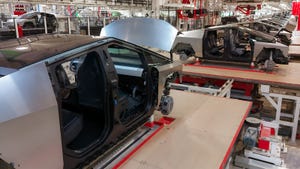Online shopping giant Amazon aims to deploy 100,000 electric vans built by EV specialist Rivian.
October 16, 2020

Amazon is aiming to make its signature gray electric-powered delivery vans the iconic parcel truck of the 21st century, much as the ubiquitous brown UPS truck filled that role in the 20th century.
The first step in that journey was Amazon’s receipt of its very first electric van from EV manufacturer Rivian. The shift of the fleet to electric power is part of Amazon’s commitment to be net-zero carbon by 2040.
To achieve that, the online shopping giant aims to have 10,000 of the custom-designed vans on the road by 2022 and to replace its entire 100,000-vehicle fleet with electric models by 2030.

This first van is just one of three that Amazon has designed with Rivian to fill the various delivery roles needed. The vans will be manufactured at Rivian's plant in Normal, Illinois, and will come in three sizes, with multiple battery sizes so they can be optimized for specific delivery routes.
It incorporates industry-leading safety, navigation, and design features, including:
State-of-the-art sensor detection, a suite of highway and traffic assist technology, and a large windshield to enhance driver visibility.
Exterior cameras around the vehicle that are linked to a digital display inside the cabin, giving the driver a 360-degree view outside the vehicle.
Alexa integration for hands-free access to route information and the latest weather updates.
A strengthened door on the driver’s side for additional protection.
A “dancefloor” space where the passenger seat would be, for easy movement inside the van.
Bright taillights surrounding the rear of the vehicle to easily detect braking.
Three levels of shelving with a bulkhead door, which can easily be opened and closed for additional driver protection while on the road.
Amazon says it surveyed the EV landscape and came up empty in its search for suitable delivery vehicles, which is why the company decided to commission its own vans from Rivian.
"When we set out to create our first customized electric delivery vehicle with Rivian, we knew that it needed to far surpass any other delivery vehicle. We wanted drivers to love using it and customers to feel excited when they saw it driving through their neighborhood and pulling up to their home," said Ross Rachey, Director of Amazon's Global Fleet and Products. "We combined Rivian’s technology with our delivery logistics knowledge, and the result is what you see here-the future of last-mile delivery."
In addition to its own reduced CO2 output, the company says it is hoping to lead other fleet operators to embrace EVs. "We hope our custom electric vehicle helps create a sense of urgency in the industry to think big about embracing sustainable technology and solutions—whether you're a package delivery company, a logistics company, an ice cream manufacturer, or almost anyone else with vehicles on the road," said Rachey.
The company revealed the full-size clay model of the van earlier this year at Rivian headquarters in Plymouth, Michigan. Its design targets a drivers’ wish list for the next-generation parcel vehicle, especially focusing on things like how the seat feels, the ease of getting in and out of the vehicles, package loading and unloading, and visibility.
The development team also included a suite of advanced safety technology such as automated emergency braking, front-wheel and all-wheel drive options, lane keep assist, a pedestrian warning system, traffic design recognition, and an automatic warning system that detects and alerts distracted driver behavior.
The instrument panel incorporates Amazon's logistics management, along with routing and package delivery technology systems to make it easier for the drivers to focus on operating the vehicle. This eliminates the need for extra devices to provide address and mapping information.
Additionally, Amazon Alexa voice control will make it easy for drivers to ask for help or use simple voice commands in the cargo bay when sorting packages without having to manually enter commands or consult handheld devices.
Of course, electric vans require electric charging infrastructure to support them, so Amazon is working on that too. "We are working to advance and implement the technology that will support these vans—ranging from the physical charging infrastructure to enhancements and optimization of our delivery stations,” said Rachey.
The infrastructure will need to be in place by next year, because that’s when Amazon plans to start using the electric vans to deliver parcels to customers as it moves toward its ambitious goals of 10,000 vehicles by the following year and 100,000 of them by 2030.
About the Author(s)
You May Also Like





